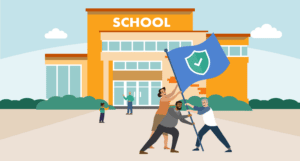Listen to this blog
4 minutes
Ensuring the safety and well-being of students in K-12 schools is paramount for Catholic Dioceses in the United States. Creating a secure environment that fosters learning, spiritual growth, and emotional wellbeing is imperative—and requires abandoning the misconception that the close-knit communities in Catholic schools make them immune to violence.
Implementing effective school safety measures is essential for ensuring the overall safety of students in Catholic schools. Let’s look at school safety best practices—and the technology-based solutions that can help Catholic schools address their unique safety needs.
School Safety Best Practices
While some Catholic schools are blessed with dedicated campuses and buildings, most Catholic schools are using facilities that belong to local parishes. These buildings come with unique challenges.
Strengthen your hedge of protection using the following best practices for school safety and security:
- Access control is key. Because Catholic churches and other church-owned facilities are open to parishioners daily for worship and other activities, staff should attempt to limit the flow of traffic entering the school areas to a single-entry point. This will allow you to better scan who is entering the school campus—whether that’s in a standalone building or a shared site.
- Checking visitors and contractors against sex offender registries helps schools know who is on campus. Regularly reviewing and updating these checks is essential to identify any new concerns that may arise.
- Publishing and enforcing safety standards across all campuses: Having safety and security standards across all Diocesan campuses—and having audit processes regularly checking for adherence—will help create a safety culture.
- Collaboration with Local Law Enforcement: Establishing solid partnerships with local law enforcement agencies is crucial. These partnerships can foster regular communication, joint training exercises, and the sharing of best practices to enhance school safety.
- Train Staff on Student Wellness and Threat Reporting: Helping your Diocese further support your students’ spiritual growth includes helping your staff identify and intervene when students are in need of that support. Provide regular training to your staff on recognizing warning signs of a student in crisis. This can significantly contribute to the early detection—and even the early intervention of potential threats.
Where does Raptor’s safety software come in?
Safety software solutions provide an extra layer of security, enabling efficient monitoring, threat detection, and crisis management. Here are three ways Raptor can help your Diocese address the above key safety and security best practices:
- Visitor Management Systems: Implementing a robust visitor management system helps schools control access to the premises and track visitors. Raptor Visitor Management quickly scans visitor IDs against the sex offender databases of all 50 states—and your own custom lists, as well.
- Emergency Management Systems: An effective emergency notification system allows for quick dissemination of critical information to students, parents, and staff during emergencies.
- Documenting Student Wellbeing and Behavioral Threat Assessment Management: Early intervention is the most important and effective way to support a student who may be experiencing challenges they are not equipped to manage. Being able to recognize a student in the initial stages of distress empowers schools to reduce that child’s exposure and give them the support they need to cope and heal. StudentSafe’s fully integrated system will empower your Diocese with:
- Create student chronologies and track student interventions: StudentSafe enables efficient documentation, tracking, and resolution of safety-related incidents. Your approved school personnel can manage low-level concerns, create student chronologies, run BTA workflows, manage BTA cases, gain immediate insight through alerts and robust dashboards, determine trends and gaps with full-scale reporting and more.
- Threat Assessment and Management Tools: With behavioral threat assessment workflows and case management features, StudentSafe assists schools in identifying and responding to potential threats. These tools enable proactive risk assessment, threat monitoring, and intervention strategies, helping schools address safety concerns before they escalate.
- Suicide risk assessments: When school staff have a full picture, they are in a better position to collaborate with the student and caregivers and make decisions in the student’s best interest. StudentSafe includes the tools deemed best practice by the National Association of School Psychologists (NASP) and the Substance Abuse and Mental Health Services Association (SAMHSA). This means in the same system your staff uses to document low-level concerns, your trained personnel can also conduct assessments for suicide risks and manage cases for positive student outcomes.
It is essential for Catholic Dioceses to carefully assess their unique needs and select safety software solutions that align with their goals and resources. Having the right school safety and security partner makes all the difference.
Improving school safety with the right partner
A multifaceted approach is necessary to enhance school safety within Catholic Dioceses. By adopting a holistic, integrated approach, schools can continue to fulfill their mission of providing quality education and spiritual guidance while prioritizing the safety and well-being of their students.
Learn how Raptor can help improve your school’s safety and security. Schedule a demo.
Related Resources
Guide to K-12 Student Wellbeing
Strategies to Recognize, Document, and Support Students in Distress
Listen to this blog
4 minutes








